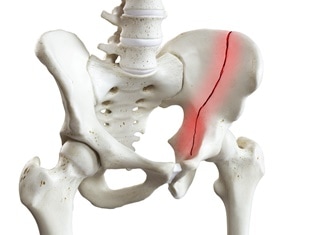A broken pelvis from a car accident is a serious injury that can have life-altering consequences. People with a broken pelvis are usually completely immobilized. A broken pelvis from a car accident can also cause organ damage and internal bleeding and make victims susceptible to infection.
Surgery and traction are often necessary for proper healing, so time off of work is usually needed. Even a minor pelvic fracture takes weeks to heal, often requiring bedrest and painkillers for an average healthy adult. In addition to lost wages, victims often face expensive medical bills. 
What it Means to Have a Broken Pelvis
Your pelvis is the butterfly-shaped group of bones that is connected to the base of the spine by ligaments. The pelvis provides protection to many of your internal organs, including the bladder and intestines. While car accidents are a major cause of broken pelvis bones, minor slip and falls can also lead to pelvic fractures, particularly in elderly adults who may have bone weakening from conditions such as osteoporosis.
There are two different types of pelvis fractures:
- A stable fracture. A stable fracture has one break point with little risk of internal bleeding or bones shifting. A full recovery is likely, but patients will usually need physical therapy and other potential treatment.
- An unstable fracture. An unstable fracture has two or more breaks and carries a higher risk of tissue and internal organ damage due to the possibility of shifting bones. Surgery is often needed to prevent or repair organ damage, and victims often need pins, plates, and screws as well as traction to recover.
An unstable pelvic fracture is serious and can be life-threatening. When an unstable pelvic fracture occurs because of a car accident, victims may also have other injuries because of the nature of the impact. Recovering from an unstable fracture is a complicated, painful experience that can take many months.
How a Broken Pelvis Happens in a Car Accident
A broken pelvis is a common collision injury, primarily because of the victim’s location and position in the vehicle. A crash can often cause excessive force being placed on the victim’s hips, pubis, or other part of the pelvis, which can crush the bone. When a car collides with another vehicle or structure, the impact travels throughout the frame of the vehicle. Those seated in the driver and passenger seats are positioned directly above the cross-section of the vehicle’s frame. This puts their pelvis regions directly above where the majority of the impact will be released.
Other factors that increase the vulnerability of drivers and passengers include:
- Seat height. Unless the vehicle is an SUV, the driver and passenger are seated in direct relation to the bumper. So when a crash occurs, the pelvis will be on the receiving end of any added impact from the bumper.
- Seat belts. Although seat belts are designed to strap over the pelvis and chest to keep people from flying forward in a collision, the force of a crash will push people into contact with the seat belt. This can cause bruising and fractures.
- Dashboard debris. The “debris” that can be forced into the pelvic area during a crash includes airbags, the dashboard and steering wheel, and the front of the car. All of these can move toward people in a crash, contributing to a broken pelvis injury.
Contact Us After a Broken Pelvis
Healing from a broken pelvis is a painful process that can take many months of medical treatment and physical therapy. The value of your case will depend on the unique circumstances of your accident as well as your past and future medical expenses, your past and future lost income, the pain and suffering you experienced, and how well your injury is expected to heal.
You need an experienced car accident attorney to fight for a full recovery. Don’t try to navigate the legal system without an attorney. If you broke your pelvis in a car accident that was not your fault, you have a better chance of receiving the damages you deserve if you work with an attorney. Give us a call, or fill out our confidential contact form.
|
Related links: |

